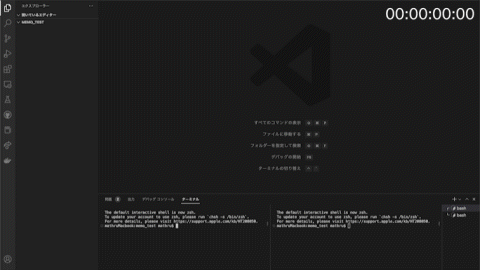Flutter多功能开发框架插件masamune的使用
Flutter多功能开发框架插件masamune的使用
Introduction
Masamune Framework是由mathru.net开发的一个Flutter多功能开发框架插件,旨在减少应用程序开发中的大部分编码工作。通过CLI工具生成代码模板和build_runner自动生成额外代码,使开发者能够专注于业务逻辑,同时确保代码的一致性和可维护性。以下是Masamune Framework的一些核心功能:
- CLI代码模板生成
- 自动代码生成
- 路由管理
- 数据库支持(NoSQL)
- 状态管理
- 翻译管理
- 主题管理
- 共享偏好设置
- 表单构建
- UI支持
- Firebase/Firestore集成

[GitHub] | [YouTube] | [Packages] | [Twitter] | [Threads] | [LinkedIn] | [mathru.net]
Installation
安装CLI工具
flutter pub global activate katana_cli添加Masamune Framework到现有项目
flutter pub add masamune
flutter pub add json_annotation
flutter pub add freezed_annotation
flutter pub add --dev build_runner
flutter pub add --dev masamune_builder
flutter pub add --dev json_serializable
flutter pub add --dev freezedProject Creation
执行以下命令创建新项目:
katana create [Application ID(e.g. com.test.myapplication)]这将自动完成以下配置:
- 图片文件放置在
assets文件夹下 - 自动生成
katana.yaml - 自动安装所需包
- 自动设置VSCode启动器
- 使用
build_runner生成代码
Code Change Monitoring
使用build_runner监控代码变化并自动生成代码:
katana code watch如果需要手动触发代码生成:
katana code generateImplementation
Page
创建页面
katana code page [Page name]页面类示例:
@immutable
@PagePath("test")
class TestPage extends PageScopedWidget {
const TestPage({super.key});
static const query = _$TestPageQuery();
@override
Widget build(BuildContext context, PageRef ref) {
return UniversalScaffold();
}
}页面跳转
router.push(TestPage.query());
router.replace(TestPage.query());
router.pop();设置初始页面
final initialQuery = TestPage.query();Data Model
创建集合模型
katana code collection [Collection name]集合模型类示例:
@freezed
@formValue
@immutable
@CollectionModelPath("test")
class TestModel with _$TestModel {
const factory TestModel({
required String name,
String? test,
}) = _TestModel;
factory TestModel.fromJson(Map<String, Object?> json) => _$TestModelFromJson(json);
static const document = _$TestModelDocumentQuery();
static const collection = _$TestModelCollectionQuery();
static const form = _$TestModelFormQuery();
}使用模型
final testModelCollection = ref.app.model(TestModel.collection());
testModelCollection.load();Controller
创建控制器:
katana code controller [Controller name]控制器类示例:
@Controller(autoDisposeWhenUnreferenced: false)
class TestController extends ChangeNotifier {
TestController();
static const query = _$TestControllerQuery();
}获取控制器:
final testController = ref.page.controller(TestController.query());State Management
使用ref.app.model和ref.(page/app).controller进行状态管理。
Translation
翻译通过Google Spreadsheet实现:
@GoogleSpreadSheetLocalize(
"https://docs.google.com/spreadsheets/d/1bw7IXEr7BGkZ4U6on0OuF7HQkTMgDSm6u5ThpBkDPeo/edit#gid=551986808",
version: 1,
)
class AppLocalize extends _$AppLocalize {}使用翻译文本:
Text(l().success);Theme Management
定义主题:
@appTheme
final theme = AppThemeData(
primary: Colors.blue,
secondary: Colors.cyan,
onPrimary: Colors.white,
onSecondary: Colors.white,
);使用主题:
return UniversalScaffold(
appBar: UniversalAppBar(title: Text("Title"), backgroundColor: theme.color.secondary),
body: UniversalColumn(
crossAxisAlignment: CrossAxisAlignment.start,
children:[
Center(child: CircleAvatar(backgroundImage: theme.asset.userIcon.provider)),
Text("User Name", style: theme.text.displayMedium)
]
)
);Form Building
获取表单控制器:
final memo = const MemoModel(title: "", text: "");
final formController = ref.page.form(MemoModel.form(memo));绘制表单并验证:
FormTextField(
form: formController,
onSaved: (value) => formController.value.copyWith(email: value),
),
FormButton(
"Login",
onPressed: () async {
final LoginValue loginValue = formController.validate();
if (loginValue == null) {
return;
}
try {
// Normal processing
} catch (e) {
// Error handling
}
},
),UI Support
显示对话框:
Modal.alert(
title: "Title",
text: "Contents text",
submitText: "OK",
onSubmit: () {
// Processing when the OK button is pressed
},
);响应式布局:
return UniversalScaffold(
breakpoint: Breakpoint.sm,
sideBar: UniversalSideBar(
decoration: const BoxDecoration(
border: Border(right: BorderSide(color: Colors.grey)),
),
children: [
for (var i = 0; i < 100; i++)
ListTile(
tileColor: Colors.blue,
title: Text((i + 1).toString()),
),
],
),
appBar: UniversalSliverAppBar(
title: const Text("UniversalViewPage"),
subtitle: const Text("UniversalViewPage"),
titlePosition: UniversalAppBarTitlePosition.bottom,
background: UniversalAppBarBackground(theme.asset.image.provider),
),
body: UniversalListView(
onRefresh: () {
return Future.delayed(1.s);
},
padding: const EdgeInsets.only(top: 32),
children: [
UniversalColumn(
children: [
...List.generate(100, (i) {
return ListTile(
tileColor: Colors.red,
title: Text((i + 1).toString()),
);
}).mapResponsive(sm: 6, md: 4),
],
),
],
),
);Authentication
用户注册和登录:
await appAuth.register(
EmailAndPasswordAuthQuery.register(
email: "test@email.com",
password: "12345678",
),
);
await appAuth.signIn(
EmailAndPasswordAuthQuery.signIn(
email: "test@email.com",
password: "12345678",
),
);
await appAuth.signOut();File Storage
上传文件:
final storage = Storage(const StorageQuery("test/file"));
final pickedData = await FilePicker.platform.pickFiles();
storage.upload(pickedData.first.path);Firebase/Firestore Support
添加Firebase相关包:
flutter pub add katana_auth_firebase
flutter pub add katana_model_firestore
flutter pub add katana_storage_firebase初始化Firebase:
flutterfire configure切换适配器:
final modelAdapter = FirestoreModelAdapter(options: DefaultFirebaseOptions.currentPlatform);
final authAdapter = FirebaseAuthAdapter(options: DefaultFirebaseOptions.currentPlatform);
final storageAdapter = FirebaseStorageAdapter(options: DefaultFirebaseOptions.currentPlatform);示例代码
以下是main.dart的完整示例代码:
import 'package:flutter/material.dart';
import 'package:masamune/masamune.dart';
part 'main.theme.dart';
part 'main.localize.dart';
const title = "";
const initialQuery = null;
const modelAdapter = RuntimeModelAdapter();
const authAdapter = RuntimeAuthAdapter();
const storageAdapter = LocalStorageAdapter();
const functionsAdapter = RuntimeFunctionsAdapter();
@appTheme
final theme = AppThemeData(
primary: Colors.blue,
secondary: Colors.cyan,
onPrimary: Colors.white,
onSecondary: Colors.white,
);
final router = AppRouter(
boot: null,
initialQuery: initialQuery,
redirect: [],
pages: [],
);
final l = AppLocalize();
@GoogleSpreadSheetLocalize(
[
"https://docs.google.com/spreadsheets/d/1bw7IXEr7BGkZ4U6on0OuF7HQkTMgDSm6u5ThpBkDPeo/edit#gid=551986808"
],
version: 1,
)
class AppLocalize extends _$AppLocalize {}
final appRef = AppRef();
final appAuth = Authentication();
final appFunction = Functions();
const flavor = String.fromEnvironment("FLAVOR");
void main() {
runMasamuneApp(
(adapters) => MasamuneApp(
title: title,
appRef: appRef,
theme: theme,
routerConfig: router,
localize: l,
authAdapter: authAdapter,
modelAdapter: modelAdapter,
storageAdapter: storageAdapter,
functionsAdapter: functionsAdapter,
masamuneAdapters: adapters,
),
);
}以上是Masamune Framework的核心功能和使用方法,希望对您有所帮助!
更多关于Flutter多功能开发框架插件masamune的使用的实战系列教程也可以访问 https://www.itying.com/category-92-b0.html
在Flutter开发中,masamune 是一个功能丰富的多功能开发框架插件,它提供了一系列预构建的组件和功能,以加速开发过程。以下是一个简单的示例,展示如何在Flutter项目中使用 masamune 插件。
首先,确保你已经在 pubspec.yaml 文件中添加了 masamune 依赖:
dependencies:
flutter:
sdk: flutter
masamune: ^最新版本号 # 请替换为实际的最新版本号然后,运行 flutter pub get 来获取依赖。
接下来,我们来看一个简单的示例,展示如何使用 masamune 中的一些功能。例如,使用 MasamuneApp 小部件来创建一个具有全局功能的 Flutter 应用。
import 'package:flutter/material.dart';
import 'package:masamune/masamune.dart';
void main() {
// 初始化 MasamuneApp
runApp(
MasamuneApp(
home: MyHomePage(),
// 配置全局设置,如主题、语言等
theme: ThemeData(
primarySwatch: Colors.blue,
),
// 配置其他全局功能,如用户认证、数据库连接等
// authentication: MyAuthentication(),
// database: MyDatabase(),
),
);
}
class MyHomePage extends StatefulWidget {
@override
_MyHomePageState createState() => _MyHomePageState();
}
class _MyHomePageState extends State<MyHomePage> {
@override
Widget build(BuildContext context) {
return Scaffold(
appBar: AppBar(
title: Text('Masamune 示例'),
),
body: Center(
child: Column(
mainAxisAlignment: MainAxisAlignment.center,
children: <Widget>[
// 使用 Masamune 的按钮组件
MasamuneButton(
text: '点击我',
onPressed: () {
// 触发点击事件
ScaffoldMessenger.of(context).showSnackBar(
SnackBar(content: Text('按钮被点击了!')),
);
},
),
// 使用 Masamune 的间隔组件
MasamuneGap(height: 20),
// 使用 Masamune 的文本组件
MasamuneText(
'欢迎使用 Masamune!',
style: TextStyle(fontSize: 24),
),
],
),
),
);
}
}在这个示例中,我们做了以下几件事情:
- 引入
masamune包:在文件顶部引入了masamune包。 - 初始化
MasamuneApp:使用MasamuneApp小部件作为应用的根小部件,并配置了全局主题。 - 创建主页面:创建了一个简单的
MyHomePage页面,其中包含MasamuneButton、MasamuneGap和MasamuneText等masamune提供的组件。
这只是 masamune 功能的冰山一角。masamune 还提供了用户认证、数据库操作、文件存储、通知推送等丰富的功能。你可以查阅 masamune 的官方文档来获取更多详细信息和高级用法。
请注意,由于 masamune 插件的功能非常丰富,具体使用时可能需要根据你的项目需求进行进一步的配置和定制。







